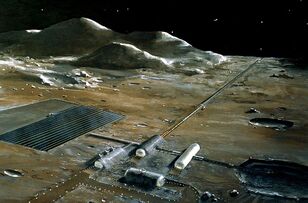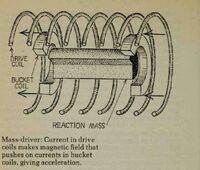No edit summary |
mNo edit summary Tag: Visual edit |
||
| Line 1: | Line 1: | ||
| − | A '''mass driver''' is a proposed method of [[non-rocket spacelaunch]] and [[better launches]]. There are two kinds: ground-based mass drivers, and on-board mass drivers that fling out large pieces of material into |
+ | A '''mass driver''' is a proposed method of [[non-rocket spacelaunch]] and [[better launches]]. There are two kinds: ground-based mass drivers, and on-board mass drivers that fling out large pieces of material into space to propel a spacecraft.[[File:800px-Lunar_base_concept_drawing_s78_23252.jpg|thumb|308x308px|Artist's conception of a mass driver facility on the Moon.]][[File:Mass_driver_original_sketch.jpg|thumb|200px|Sketch of Mass Driver on O'Neill's book.]] |
A ground-based mass driver is basically a big magnetic catapult. It can, through magnetic impulses driven by electric current, accelerate a "bucket" containing a payload to orbital os escape speeds. The bucket will release the payload after accelerating, and therefore it will be re-used. A launch can be made every few minutes. Even though the cost of a bucket may be expensive, after years of use it will constitute a small fraction of the cost of each launch. |
A ground-based mass driver is basically a big magnetic catapult. It can, through magnetic impulses driven by electric current, accelerate a "bucket" containing a payload to orbital os escape speeds. The bucket will release the payload after accelerating, and therefore it will be re-used. A launch can be made every few minutes. Even though the cost of a bucket may be expensive, after years of use it will constitute a small fraction of the cost of each launch. |
||
| Line 11: | Line 11: | ||
On Earth, a fully functional (not just a prototype) mass driver could probably be constructed ''today'' using most of the same components as existing maglev trains. |
On Earth, a fully functional (not just a prototype) mass driver could probably be constructed ''today'' using most of the same components as existing maglev trains. |
||
| + | == References == |
||
| + | # O'Neill, Gerard K. ''The High Frontier: Human Colonies in Space''. Burlington, Ont.: Apogee Books, 2000. ISBN: 189652267X |
||
{{stub}} |
{{stub}} |
||
{{wikipedia}} |
{{wikipedia}} |
||
Revision as of 23:30, 11 December 2018
A mass driver is a proposed method of non-rocket spacelaunch and better launches. There are two kinds: ground-based mass drivers, and on-board mass drivers that fling out large pieces of material into space to propel a spacecraft.

Artist's conception of a mass driver facility on the Moon.

Sketch of Mass Driver on O'Neill's book.
A ground-based mass driver is basically a big magnetic catapult. It can, through magnetic impulses driven by electric current, accelerate a "bucket" containing a payload to orbital os escape speeds. The bucket will release the payload after accelerating, and therefore it will be re-used. A launch can be made every few minutes. Even though the cost of a bucket may be expensive, after years of use it will constitute a small fraction of the cost of each launch.
The mass driver would need to be a few kilometers in length to reach the necessary speeds. To send humans and delicate instruments into orbit, however, the mass driver would have to be several hundreds of kilometers long to avoid excessive g-forces.
Such a devide could be built in the Moon. It would be particularly useful there, since there isn't an atmosphere. The power needed would come from a solar farm. The lunar mass driver is an excellent option to put objects in orbit, becuase rocket fuel isn't available on the Moon , but solar energy is.
Various prototypes have been made in the last decades. The physicist and Princeton professor Gerard O'Neill made one with a budget of $2,000. Its payload reached speeds up to 40 meters per second.
On Earth, a fully functional (not just a prototype) mass driver could probably be constructed today using most of the same components as existing maglev trains.
References
- O'Neill, Gerard K. The High Frontier: Human Colonies in Space. Burlington, Ont.: Apogee Books, 2000. ISBN: 189652267X
| This page uses Creative Commons Licensed content from Wikipedia (view authors). | 
|